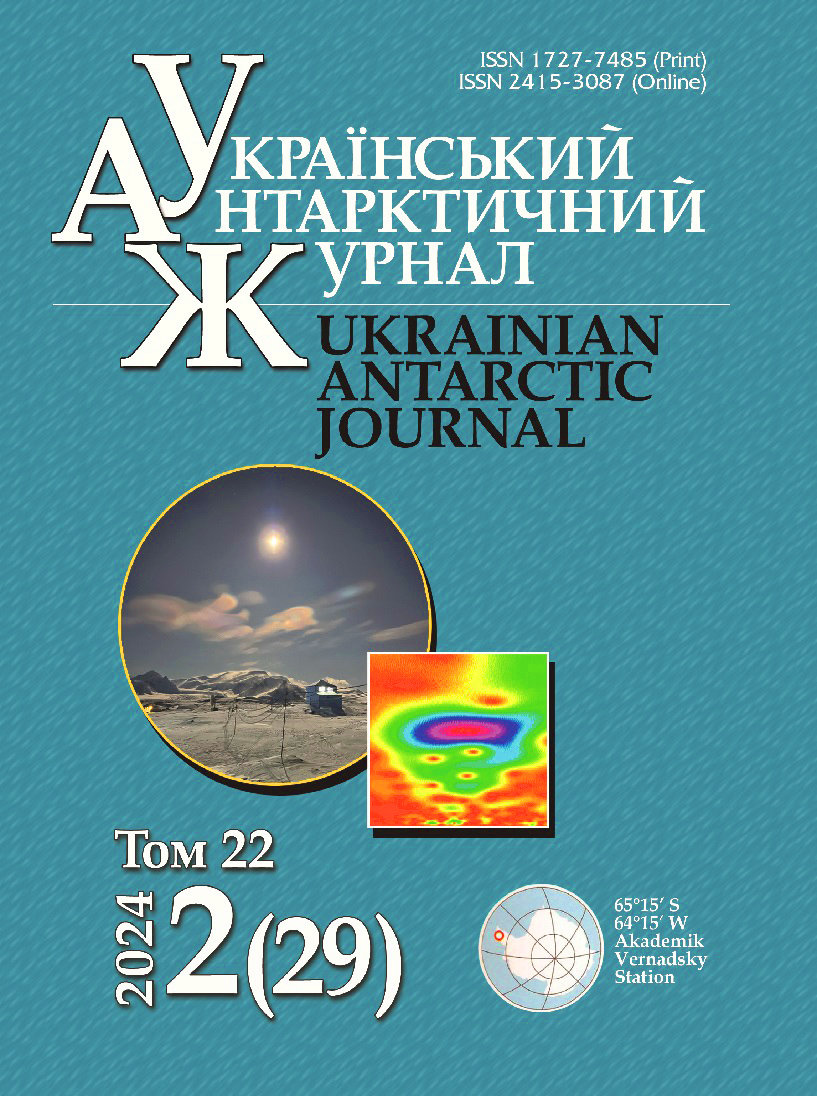Поліморфізм довжини інтронів генів β-тубуліну у Colobanthus quitensis в регіоні Аргентинських островів – півострова Київ
- Антарктичний півострів,
- генетичний поліморфізм,
- перлинниця антарктична,
- природні популяції
Авторське право (c) 2024 Український антарктичний журнал

Ця робота ліцензується відповідно до Creative Commons Attribution-NonCommercial-NoDerivatives 4.0 International License.
Анотація
Генетичні маркери, засновані на оцінці поліморфізму довжини інтронів генів (Intron Length Polymorphism, ILP), в останні роки набули значної популярності в популяційно-генетичних дослідженнях рослин. Один з найпопулярніших ILP-маркерів, що базується на оцінці поліморфізму довжини інтронів генів β-тубуліну різних видів рослин – TBP (Tubulin-Based-Polymorphism). Цей метод широко використовується для швидкого молекулярно-генетичного аналізу різних видів рослин, адже дозволяє використовувати всього одну комбінацію вироджених праймерів для будь-якої рослинної ДНК. В роботі проаналізовано поліморфізм довжини інтронів генів β-тубуліну в популяціях перлинниці антарктичної (Colobanthus quitensis) з відносно компактного регіону Аргентинських островів – півострова Київ: 93 зразки C. quitensis з 11 ізольованих острівних популяцій. Результати аналізу поліморфізму довжини двох інтронів генів β-тубуліну в природних популяціях C. quitensis загалом свідчать про низький рівень генетичного поліморфізму, що підтверджує загальні уявлення щодо генетичної мінливості C. quitensis в Антарктичному регіоні. За даними оцінки поліморфізму довжини першого інтрону виявлено дві групи популяцій C. quitensis, що може вказувати на походження рослин з різних регіонів. При цьому ДНК-фрагменти детектуються в діапазоні від 380 п.н. до 1900 п.н., а серед проналізованих популяцій C. quitensis виділяються популяції з острова Дарбу, мису Перес та частина зразків з найбільшого з островів Берселот. До того ж Берселот об'єднує рослини з обома типами ДНК-профілю. Оцінка поліморфізму довжини другого інтрону генів β-тубуліну C. quitensis дозволила ідентифікувати індивідуальні генотипи у 7 з 11 досліджених популяцій. Отримані результати можуть свідчити про накопичення мінливості відповідно до різних умов навколишнього середовища в початкових точках поширення досліджуваного виду рослин.
Посилання
- Acuna-Rodrıguez, I. S., Oses, R., Cortes-Vasquez, J., Torres-Dıaz, C., & Molina-Montenegro, M. A. (2014). Genetic diversity of Colobanthus quitensis across the Drake Passage. Plant Genetic Resources, 12(1), 147–150. https://doi.org/10.1017/S1479262113000270
- Alban, D. M., Biersma, E. M., Kadereit, J. W., & Dillenberger, M. S. (2022). Colonization of the Southern Hemisphere by Sagina and Colobanthus (Caryophyllaceae). Plant Systematics and Evolution, 308, 1. https://doi.org/10.1007/s00606-021-01793-w
- Andreev, I. O., Parnikoza, I. Yu., Konvalyuk, I. I., Metcheva, R., Kozeretska, I. A., & Kunakh, V. A. (2022). Genetic divergence of Deschampsia antarctica (Poaceae) population groups in the maritime Antarctic. Biological Journal of the Linnean Society, 135, 223–234. https://doi.org/10.1093/biolinnean/blab141
- Androsiuk, P., Chwedorzewska, K., Szandar, K., & Giełwanowska, I. (2015). Genetic variability of Colobanthus quitensis from King George Island (Antarctica). Polish Polar Research, 36, 281–295. https://doi.org/10.1515/popore-2015-0017
- Biersma, E. M., Torres-Díaz, C., Molina-Montenegro, M. A., Newsham, K. K., Vidal, M. A., Collado, G. A., Acuña-Rodríguez, I. S., Ballesteros, G. I., Figueroa, C. C., Goodall-Copestake, W. P., Leppe, M. A., Cuba-Díaz, M., Valladares, M. A., Pertierra, L. R., & Convey, P. (2020). Multiple late-Pleistocene colonisation events of the Antarctic pearlwort Colobanthus quitensis (Caryophyllaceae) reveal the recent arrival of native Antarctic vascular flora. Journal of Biogeography, 47(8), 1663–1673. https://doi.org/10.1111/jbi.13843
- Braglia, L., Gavazzi, F., Gianì, S., Morello, L., & Breviario, D. (2023). Tubulin-Based Polymorphism (TBP) in Plant Genotyping. In Y. Shavrukov (Ed.), Plant Genotyping Methods and Protocols. Methods in Molecular Biology (vol. 2638). Humana, New York, NY. https://doi.org/10.1007/978-1-0716-3024-2_28
- Braglia, L., Lauria, M., Appenroth, K. J., Bog, M., Breviario, D., Grasso, A., Gavazzi, F., & Morello, L. (2021). Duckweed species genotyping and interspecific hybrid discovery by Tubulin-Based Polymorphism finger-printing. Frontiers in Plant Science, 12, 625670. https://doi.org/10.3389/fpls.2021.625670
- Braglia, L., Manca, A., Mastromauro, F., & Breviario, D. (2010). cTBP: A successful intron length polymorphism (ILP)–based genotyping method targeted to well defined experimental needs. Diversity, 2, 572–585. https://doi.org/10.3390/d2040572
- Breviario, D., Baird, W. V., Sangoi, S., Hilu, K., Blumetti, P., & Giani, S. (2007). High polymorphism and resolution in targeted fingerprinting with combined β-tubulin introns. Molecular Breeding, 20, 249–259. https://doi.org/10.1007/s11032-007-9087-9
- Convey, P., Gibson, J. A. E., Hillenbrand, C. D., Hodgson, D. A., Pugh, P. J. A., Smellie, J. L., & Stevens, M. I. (2008). Antarctic terrestrial life – challenging the history of the frozen continent? Biological Reviews, 83, 103–117. https://doi.org/10.1111/j.1469-185X.2008.00034.x
- Cuba-Dıaz, M., Klagges, M., Fuentes-Lillo, E., Cordero, C., Acuna, D., Opazo, G., & Troncoso-Castro, J. M. (2017). Phenotypic variability and genetic differentiation in continental and island populations of Colobanthus quitensis (Caryophyllaceae: Antarctic pearlwort). Polar Biology, 40, 2397–2409. https://doi.org/10.1007/s00300-017-2152-x
- Eckert, C., Samis, K., & Lougheed, S. (2008). Genetic variation across species’ geographical ranges: the central–marginal hypothesis and beyond. Molecular Ecology, 17, 1170–1188. https://doi.org/10.1111/j.1365-294X.2007.03659.x
- Fasanella, M., Premoli, A. C., Urdampilleta, J. D., González, M. L., & Chiapella, J. O. (2017). How did a grass reach Antarctica? The Patagonian connection of Deschampsia antarctica (Poaceae). Botanical Journal of the Linnean Society, 185, 511–524. https://doi.org/10.1093/botlinnean/box070
- Gianoli, E., Inostroza, P., Zuñiga-Feest, A., Reyes-Diaz, M., Cavieres, L. A., Bravo, L. A., & Corcuera, L. J. (2004). Ecotypic differentiation in morphology and cold resistance in population of Colobanthus quitensis (Caryophyllaceae) from the Andes of central Chile and Maritime Antarctica. Arctic, Antarctic and Alpine Research, 36, 484–489. https://doi.org/10.1657/1523-0430(2004)036[0484:EDIMAC]2.0.CO;2
- Gowd, T. Y. M., Deo, C., Manjunathagowda, D. C., Mahajan, V., Dutta, R., Bhutia, N. D., Singh, B., & Mounika, V. (2023). Deployment of Intron Length Polymorphic (ILP) markers in dissipating diversity of Allium species. South African Journal of Botany, 160, 157–165. https://doi.org/10.1016/j.sajb.2023.06.053
- Hillis, D. M., & Bull, J. J. (1993). An empirical test of bootstrapping as a method for assessing confidence in phylogenetic analysis. Systematic Biology, 42, 182–192. https://doi.org/10.1093/sysbio/42.2.182
- Kang, Y., Lee, H., Kim, M. K., Shin, S. C., Park, H., & Lee, J. (2016). The complete chloroplast genome of Antarctic pearlwort, Colobanthus quitensis (Kunth) Bartl. (Caryophyllaceae). Mitochondrial DNA Part A, 27, 4677–4678. https://doi.org/10.3109/19401736.2015.1106498
- Koc, J., Androsiuk, P., Chwedorzewska, K. J., Cuba-Diaz, M., Górecki, R., & Giełwanowska, I. (2018). Range-wide pattern of genetic variation in Colobanthus quitensis. Polar Biology, 41, 2467–2479. https://doi.org/10.1007/s00300-018-2383-5
- Lee, D. W., & Postle, R. L. (1975). Isozyme variation in Colobanthus quitensis (Kunth) Bartl.: Methods and preliminary analysis. British Antarctic Survey Bulletin, 41/42, 133–137.
- Lykholat, Y. V., Rabokon, A. M., Blume, R. Y., Khromykh, N. O., Didur, O. O., Sakharova, V. H., Kabar, A. M., Pirko, Ya. V., & Blume, Ya. B. (2022). Characterization of β-tubulin genes in Prunus persica and Prunus dulcis for fingerprinting of their interspecific hybrids. Cytology and Genetics, 56, 481–493. https://doi.org/10.3103/S009545272206007X
- Murray, M. G., & Thompson, W. F. (1980). Rapid isolation of high molecular weight plant DNA. Nucleic Acids Research, 8, 4321–4325.
- Nei, M., & Li, W. H. (1979). Mathematical model for studying genetic variation in terms of restriction endonucleases. Proceedings of the National Academy of Sciences, 76, 5269–5273. https://doi.org/10.1073/pnas.76.10.5269
- Parnikoza, I., Kozeretska, I., & Kunakh, V. (2011). Vascular plants of the Maritime Antarctic: origin and adaptation. American Journal of Plant Sciences, 2, 381–395. https://doi.org/10.4236/ajps.2011.23044
- Pascual-Díaz, J. P., Serçe, S., Hradecká, I., Vanek, M., Özdemir, B. S., Sultana, N., Vural, M., Vitales, D., & Garcia, S. (2020). Genome size constancy in Antarctic populations of Colobanthus quitensis and Deschampsia antarctica. Polar Biology, 43, 1407–1413. https://doi.org/10.1007/s00300-020-02699-y
- Pavlicek, A., Hrda, S., & Flegr, J. (1999). FreeTree – Freeware program for construction of phylogenetic trees on the basis of distance data and bootstrap/jackknife analysis of the tree robustness. Application in the RAPD analysis of genus Frenkelia. Folia Biologica (Praha), 45, 97–99.
- Rabokon, A. M., Pirko, Y. V., Demkovych, A. Ye., Andreev, I. O., Parnikoza, I. Yu., Kozeretska, I. A., Yu, Z., Kunakh, V. A., & Blume, Y. B. (2019). Intron length polymorphism of β-tubulin genes in Deschampsia antarctica E. Desv. across the western coast of the Antarctic Peninsula. Polar Science, 19, 1541–154. https://doi.org/10.1016/j.polar.2018.11.001
- Rabokon, A., Postovoitovà, A., Bilonozhko, Yu., Kalafat, L., Pavlovska, M., Prekrasna, Ie., Parnikoza, I., Kozeretska, I., Pirko, Ya., & Blume, Ya. (2020). Assessment of Colobanthus quitensis genetic polymorphism from the Argentine Islands region (maritime Antarctic) by actin, α- and γ-tubulin gene intron analysis. Ukrainian Antarctic Journal, (1), 93–101. https://doi.org/10.33275/1727-7485.1.2020.382
- Sagarin, R. D., & Gaines, S. D. (2002). The ‘abundant centre’ distribution: to what extent is it a biogeographical rule? Ecology Letters, 5(1), 137–147.
- Smith, R. I. L., & Corner, R. W. M. (1973). Vegetation of the Arthur Harbour-Argentine Islands region of the Antarctic Peninsula. British Antarctic Survey Bulletin, 33/34, 89–122.
- Sneath, P. H. A., & Sokal, R. R. (1973). Numerical Taxonomy. The principles and practice of numerical classification. W. H. Freeman and Company.
- Van de Wouw, M., van Dijk, P., & Huiskes, A. H. L. (2008). Regional genetic diversity patterns in Antarctic hairgrass (Deschampsia antarctica Desv.). Journal of Biogeography, 35, 365–376.
- Yevchun, H., Fedchuk, A., Drohushevska, I., Pnyovska, O., Chernyshenko, M., & Parnikoza, I. (2021). The toponymy of the Argentine Islands area, the Kyiv Peninsula (West Antarctica). Ukrainian Antarctic Journal, (2), 127–157. https://doi.org/10.33275/1727-7485.2.2021.683


